
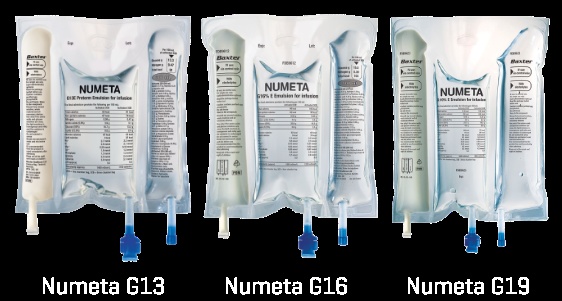
NUMETA G16%E, EMULSION FOR INFUSION


How to use NUMETA G16%E, EMULSION FOR INFUSION
Introduction
Package Leaflet: Information for the User
NUMETA G16%E emulsion for infusion
Read all of this leaflet carefully before your child starts using this medicine, because it contains important information for them.
- Keep this leaflet, you may need to read it again.
- If you have any further questions, ask your child's doctor, pharmacist, or nurse.
- If your child experiences any side effects, talk to your child's doctor, pharmacist, or nurse, even if they are not listed in this leaflet. See section 4.
Contents of the package leaflet:
- What is Numeta G16%E and what is it used for
- What you need to know before Numeta G16%E is administered to your child
- How Numeta G16%E will be administered
- Possible side effects
- Storage of Numeta G16%E
- Contents of the pack and further information
1. What is Numeta G16%E and what is it used for
Numeta G16%E is a specialized nutrition designed for term newborns to 2 years of age. It is administered through a tube connected to your child's vein when they are unable to eat all their food by mouth
Numeta comes in a three-compartment bag with three independent chambers containing:
a 50% glucose solution
a 5.9% pediatric amino acid solution with electrolytes
a 12.5% lipid (fat) emulsion
Depending on your child's needs, two (or three) of these solutions are mixed in the bag before administration to your child.
Numeta G16%E should only be used under medical supervision.
2. What you need to know before Numeta G16%E is administered to your child
Do not useNumetaG16%E in the following cases:
With 2 solutions mixed in the bag (“2 in1”):
- If your child is allergic to any of the egg, soy, or peanut proteins or to the ingredients of the glucose or amino acid bag (included in section 6).
- If your child's body has problems using the protein constituents.
- If your child has high concentrations of any of the electrolytes included in Numeta G16%E in their blood.
- If your child is a newborn (≤ 28 days old), Numeta G16%E (or other solutions containing calcium) should not be administered with the antibiotic ceftriaxone at the same time, even if separate infusion lines are used. There is a risk of particle formation in the newborn's blood that can be fatal)
- If your child has hyperglycemia (especially high blood sugar levels).
With 3 solutions mixed in the bag (“3 in1”).
- All situations mentioned in “2 in 1” plus the following:
- If your child has a particularly high level of fat in their blood.
In all cases, your child's doctor will decide whether to administer this medicine to your child based on factors such as age, weight, and medical condition, along with the results of all tests performed.
Warnings and precautions
Consult your child's doctor or nurse before Numeta G16%E is administered.
When used in newborns and children under 2 years, the emulsion (in the bags and administration equipment) should be protected from light exposure until administration is complete. Exposure of Numeta G16%E to ambient light, especially after mixing with oligoelements or vitamins, generates peroxides and other degradation products that can be reduced if the product is protected from light exposure.
Allergic reactions
Infusion should be stopped immediately if any signs or symptoms of an allergic reaction appear (such as fever, sweating, chills, headache, skin rash, or difficulty breathing). This medicine contains soybean oil, which can rarely cause hypersensitivity reactions. In rare cases, it has been observed that some people who are allergic to peanut proteins are also allergic to soybean proteins.
Numeta G16%E contains glucose from cornstarch, so it should be used with caution in patients with known allergy to corn or its products.
Risk of particle formation with ceftriaxone (antibiotic):
The antibiotic ceftriaxone should not be mixed or administered at the same time as a solution containing calcium (including Numeta G16%E) through an infusion line.
Your child's doctor is aware of this and will not administer them together, even through separate infusion lines or sites.
However, your child's doctor may administer calcium and ceftriaxone sequentially, one after the other, if infusion lines are used at different points, or if infusion lines are replaced or thoroughly flushed with physiological saline solution to avoid precipitate formation.
Formation of small particles in the blood vessels of the lungs:
Difficulty breathing can also be a sign of the formation of small particles that obstruct the blood vessels of the lungs (pulmonary vascular precipitates). If your child experiences difficulty breathing, inform your child's doctor or nurse. They will decide on the measures to be taken.
Infection and sepsis
Your child's doctor will closely monitor your child for any symptoms of infection. The use of an "aseptic technique" (germ-free technique) when placing and maintaining the catheter, as well as when preparing the nutrition formula, can reduce the risk of infection.
Occasionally, children may develop infections and sepsis (bacteria in the blood) when they have a tube connected to a vein (intravenous catheter). Certain medications and diseases can increase the risk of developing sepsis or infection. Patients who require parenteral nutrition (nutrition administered through a tube connected to a vein) are more likely to develop an infection due to their medical condition.
Fat overload syndrome
Cases of fat overload syndrome have been described with similar products. A reduction in the ability to eliminate the lipids contained in Numeta G16%E, or an overdose, can cause a "fat overload syndrome" (see sections 3 and 4 Possible side effects).
Changes in blood chemical levels
Your child's doctor will check and review the fluids in your child's body, blood chemical levels, and other blood levels, as refeeding someone who is severely malnourished can lead to changes in blood chemistry. Excess fluid in tissues and swelling can also occur. It is recommended to start parenteral nutrition slowly and under supervision.
High magnesium levels in the blood
The amount of magnesium present in Numeta G16%E can lead to high magnesium levels in the blood. Signs of these high levels include weakness, slow reflexes, nausea, vomiting, low calcium levels in the blood, breathing difficulties, low blood pressure, and irregular heartbeats. Since it may be difficult to detect these signs, your child's doctor may monitor your child's blood values, especially if your child has risk factors related to high magnesium levels in the blood, including impaired kidney function. If magnesium levels in the blood are high, infusion will be stopped or reduced.
Monitoring and adjustment
Your child's doctor will monitor and adjust the dose of Numeta G16%E to meet your child's individual needs if they have the following conditions:
- severe post-traumatic state
- severe diabetes mellitus
- shock
- infarction
- severe infection
- certain types of coma
Use with caution:
Numeta G16%E should be used with caution if your child has:
- pulmonary edema (fluid in the lungs) or heart failure,
- severe liver problems,
- problems absorbing nutrients,
- high blood sugar levels,
- kidney problems,
- severe metabolic disorders (when the body cannot eliminate substances normally),
- blood coagulation disorders.
The fluid levels in your child's body, liver analysis values, and blood values will be carefully monitored.
Use of Numeta G16%E with other medicines
Tell your child's doctor if your child is using, has recently used, or may need to use any other medicine.
Numeta G16%Emust not be administered at the same time as:
- ceftriaxone(an antibiotic) even through separate infusion lines, due to the risk of particle formation.
- bloodthrough the same infusion line, due to the risk of pseudoagglutination (red blood cells become stacked)
- ampicillin,phenytoin, and furosemidethrough the same infusion line, as there is a risk of particle formation.
Coumarin and warfarin (anticoagulants)
Your child's doctor will closely monitor your child if they are taking coumarin or warfarin. Olive and soybean oil contain vitamin K1. Vitamin K1 can interfere with the action of medicines like coumarin and warfarin. These medicines are anticoagulants used to prevent blood clotting.
Laboratory tests
The lipids included in this emulsion can interfere with the results of certain laboratory tests. Laboratory tests can be performed after a period of 5 to 6 hours if no more lipids are administered.
Interaction of Numeta G16%Ewith medicines that may affect potassium levels/metabolism:
Numeta G16%E contains potassium. High potassium levels in the blood can cause an abnormal heart rhythm. Special attention should be paid to patients who take diuretics (medicines that reduce fluid retention), ACE inhibitors, or angiotensin II receptor antagonists (all used to treat high blood pressure) or immunosuppressants (medicines that can decrease the body's natural defenses). This type of medicine can increase potassium levels.
3. How Numeta G16%E will be administered
Your child will always be administered Numeta G16%E exactly as their doctor has indicated. Consult your child's doctor if you have any doubts.
Age range
Numeta G16%E has been designed to meet the nutritional needs of term newborns and children up to 2 years of age.
The doctor will decide if this medicine is suitable for your child.
Administration
This medicine is an emulsion for infusion. It is administered through a plastic tube connected to a vein in your child's arm or a large vein in their chest.
Your child's doctor may choose not to administer lipids to your child. The design of the Numeta G16%E bag allows the non-permanent seal between the amino acid/electrolyte and glucose chambers to be broken, if necessary. The seal between the amino acid and lipid chambers remains intact in this case. The contents of the bag can be infused without lipids.
When used in newborns and children under 2 years, the emulsion (in the bags and administration equipment) should be protected from light exposure until administration is complete (see section 2).
Dosage and duration of treatment
Your child's doctor will decide on the dose your child needs and how long they will receive it. The dose depends on your child's nutritional needs and will be based on their weight, medical condition, and the body's ability to digest and absorb the ingredients of Numeta G16%E. Additional protein or nutrition may also be administered orally or enterally.
If your child is given too muchNumetaG16%E
In case of overdose or accidental ingestion, consult the Toxicology Information Service. Telephone 915.620.420
Symptoms
Receiving too much medicine or administering it too quickly could cause:
- nausea (feeling unwell)
- vomiting
- chills
- electrolyte disturbances (inappropriate amounts of electrolytes in the blood)
- signs of hypervolemia (increased blood volume)
- acidosis (increased blood acidity)
In these cases, infusion should be stopped immediately. Your child's doctor will decide if other actions are necessary.
An overdose of the fats contained in Numeta G16%E can cause a "fat overload syndrome", which is usually reversible once the infusion is interrupted. In newborns (neonates) and small children (infants), the fat overload syndrome has been associated with respiratory disorders that cause a reduction in oxygen in the body (difficulty breathing) and conditions that cause an increase in blood acidity (acidosis).
To avoid these reactions, your child's doctor will regularly monitor your child's condition and analyze their blood levels during treatment.
4. Possible side effects
Like all medicines, this medicine can cause side effects, although not all children will experience them.
If you notice any change in the way your child feels during or after treatment, inform your child's doctor or nurse immediately.
The tests your child's doctor will perform on your child while they receive this medicine should minimize the risk of side effects.
If symptoms of an allergic reaction occur, infusion should be stopped and your child's doctor contacted immediately. This can be serious and symptoms may include:
- Sweating
- Chills
- Headache
- Skin rash
- Difficulty breathing
Other side effects that have been observed are:
Frequent: may affect up to 1 in 10 people
- Low phosphate levels in the blood (hypophosphatemia)
- High blood sugar levels (hyperglycemia)
- High calcium levels in the blood (hypercalcemia)
- High triglyceride levels in the blood (hypertriglyceridemia)
- Electrolyte disturbances (hyponatremia)
Rare: may affect up to 1 in 100 people
- High lipid levels in the blood (hyperlipidemia)
- A disorder in which bile cannot flow from the liver to the duodenum (cholestasis). The duodenum is part of the intestine
Unknown: frequency cannot be estimated from available data (these side effects have been reported with Numeta G13%E and G16%E when administered peripherally with insufficient dilution)
- Skin necrosis
- Soft tissue damage
- Extravasation
The following side effects have been reported with other parenteral nutrition products:
- The reduced or limited ability to eliminate the lipids contained in Numeta G16%E can lead to a "fat overload syndrome". The following signs and symptoms of this syndrome are usually reversible when the lipid emulsion infusion is stopped:
- Sudden and severe worsening of the patient's medical condition
- High fat levels in the blood (hyperlipidemia)
- Fever
- Fatty infiltration of the liver (hepatomegaly)
- Worsening of liver function
- Decreased red blood cell count, which can cause pale skin and weakness or difficulty breathing (anemia)
- Low white blood cell count, which can increase the risk of infection (leucopenia)
- Low platelet count, which can increase the risk of bruising and/or bleeding (thrombocytopenia)
- Coagulation disorders, which affect the blood's ability to clot
- Respiratory disorder that causes a reduction in oxygen in the body (difficulty breathing)
- Conditions that cause an increase in blood acidity (acidosis)
- A coma that requires hospitalization
- Formation of small particles that can cause obstruction of the blood vessels of the lungs (pulmonary vascular precipitates) or difficulty breathing
Reporting of side effects:
If your child experiences any side effects, talk to your child's doctor or nurse, even if it is possible that they are not listed in this leaflet. You can also report them directly through the Spanish Pharmacovigilance System for Human Use Medicines: https://www.notificaram.es. By reporting side effects, you can help provide more information on the safety of this medicine.
5. Storage of Numeta G16%E
Keep this medicine out of the sight and reach of children when not being administered.
When used in newborns and children under 2 years, the emulsion (in the bags and administration equipment) should be protected from light exposure until administration is complete (see section 2).
Do not use this medicine after the expiry date stated on the bag and outer packaging (MM/YYYY). The expiry date is the last day of the month indicated.
Do not freeze.
Store in the overbag.
Medicines should not be disposed of via wastewater or household waste. Ask your pharmacist how to dispose of medicines no longer required. This will help protect the environment.
6. Container Contents and Additional Information
Product Appearance and Container Contents
Numeta G16%E is presented in a three-chamber bag. Each bag contains a sterile combination of a glucose solution, a pediatric amino acid solution with electrolytes, and a lipid emulsion, as described below:
Container Size | 50% Glucose Solution | 5.9% Amino Acid Solution with Electrolytes | 12.5% Lipid Emulsion |
500 ml | 155 ml | 221 ml | 124 ml |
Appearance before reconstitution:
- The amino acid and glucose solutions in the chambers are clear, colorless, or slightly yellowish.
- The lipid emulsion chamber has a milky, white appearance.
Appearance after reconstitution:
- The "2 in 1" solution is clear, colorless, or slightly yellowish.
- The "3 in 1" emulsion for infusion has a uniform, milky, white appearance.
The three-chamber bag is a multilayer plastic bag.
To prevent contact with air, Numeta is packaged inside an oxygen barrier overbag containing an oxygen absorber packet and an oxygen indicator.
Container Sizes
500 ml bag: 6 units per box
1 bag of 500 ml
Only certain container sizes may be marketed.
Marketing Authorization Holder and Manufacturer
Marketing Authorization Holder
Baxter, S.L.
Pouet de Camilo 2, 46394 Ribarroja del Turia (Valencia)
Manufacturer
Baxter S.A.
Boulevard Rene Branquart, 80
7860 Lessines
Belgium
This medicinal product is authorized in the Member States of the European Economic Area under the following names:
Austria Germany | Numeta G16 % E Emulsion zur Infusion |
Belgium Luxembourg | Numetzah G16%E, émulsion pour perfusion |
France | Numetah G16 %E émulsion pour perfusion |
Denmark Norway Sweden | Numeta G16E |
Czech Republic Greece | Numeta G16 % E |
Netherlands | Numeta G16%E emulsie voor infusie |
Ireland United Kingdom | Numeta G16%E, Emulsion for Infusion |
Italy | Numeta G16%E emulsione per infusione |
Finland | Numeta G16E infuusioneste, emulsio |
Poland | Numeta G16 % E |
Portugal | Numeta G16%E |
Spain | Numeta G16%E, emulsión para perfusión |
Date of the last revision of this leaflet: May 2024
Detailed and up-to-date information on this medicinal product is available on the website of the Spanish Agency for Medicines and Health Products (AEMPS) http://www.aemps.gob.es/
---------------------------------------------------------------------------------------------------------------------
This information is intended only for healthcare professionals:
(*) Note that in certain cases, these medicinal products may be administered at home by parents or other caregivers. In these cases, parents/caregivers should read the following information.
No medication should be added to the bag without first checking compatibility. Particles may form or the lipid emulsion may break down, which could block blood vessels.
Numeta G16%E should be at room temperature before use.
Before administering Numeta G16%E, you must prepare the bag as shown below.
Make sure the bag is not damaged and use it only if it is not damaged. An undamaged bag has the following appearance:
- The non-permanent seals are intact. This is observed because there is no mixing of the three chambers.
- The amino acid and glucose solutions are clear, colorless, or slightly yellowish and without visible particles.
- The lipid emulsion is a milky, white liquid.
Before opening the overbag, examine the color of the oxygen absorber.
- Compare it with the reference color printed next to the OK symbol and shown in the printed area of the oxygen indicator label.
- Do not use the product if the color of the oxygen absorber does not match the reference color printed next to the OK symbol.
Figures 1 and 2 illustrate how to remove the overbag. Discard it along with the oxygen indicator and oxygen absorber.
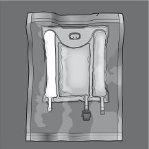
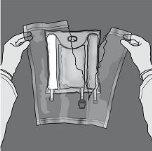
Figure 1 Figure 2
Preparation of the mixture
- Make sure the product is at room temperature before breaking the non-permanent seals.
- Place the bag on a clean, flat surface.
Activation of the 3-chamber bag (breaking of the two non-permanent seals)
Step 1: Roll the bag from the hanger side in D
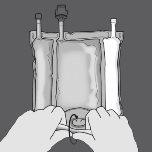
Step 2: Press until the non-permanent seals open.

Step 3: Change direction and roll the bag towards the hanger in D until the seal is completely open. Follow the same steps to open the second non-permanent seal.
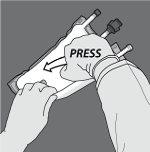
Step 4: Turn the bag at least three times to mix the contents well. The appearance of the mixed solution should be a white, milky emulsion.
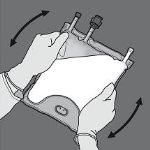
Step 5: Remove the protective cap from the administration port and insert the intravenous administration equipment.
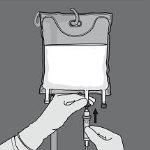
Activation of the 2-chamber bag (breaking of the non-permanent seal between the amino acid and glucose chambers)
Step 1: To break only the non-permanent seal of amino acids/glucose, start rolling the bag from the corner of the hanger in D of the seal that separates the amino acid and glucose chambers and press to open the seal that separates both compartments.
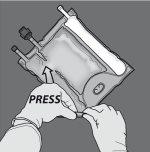
Step 2: Place the bag so that the compartment with lipid emulsion is facing the operator and roll the bag while protecting the compartment with lipid emulsion in the palms of the hands.
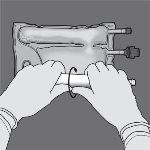
Step 3: With one hand, apply pressure by rolling the bag towards the tubes.
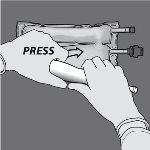
Step 4: Then, change direction and roll the bag towards the hanger in D, pressing with the other hand until the seal that separates the amino acid and glucose solutions is completely open.

Step 5: Turn the bag at least three times to mix the contents well. The appearance of the mixed solution should be clear, colorless, or slightly yellowish.
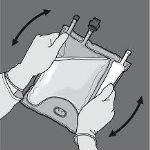
Step 6: Remove the protective cap from the administration port and insert the intravenous administration equipment.
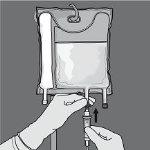
The administration rate should be gradually increased during the first hour and adjusted according to the following factors:
The dose to be administered
Daily volume intake
Infusion duration
Administration method
When used in newborns and children under 2 years, the emulsion (in the bag and in the administration equipment) should be protected from light exposure until the end of administration.
The use of a 1.2-micron filter is recommended for the administration of Numeta G16%E.
Due to its high osmolarity, Numeta G16%E can only be administered undiluted through a central vein; however, appropriate dilution of Numeta G16%E with water for injectable preparations reduces osmolarity and allows peripheral infusion.
The following formula indicates the impact of dilution on the osmolarity of the bags.
Final osmolarity | = | Bag volume x initial osmolarity |
Added water + Bag volume |
The following table shows examples of osmolarity for the additions of 2-chamber and 3-chamber bags activated after the addition of water for injectable preparations:
Amino Acids and Glucose(2-chamber bag activated) | Amino Acids, Glucose, andLipids (3-chamber bag activated) | |
Initial volume in the bag (ml) | 376 | 500 |
Initial osmolarity (mOsm/l approx) | 1585 | 1230 |
Volume of added water (ml) | 376 | 500 |
Final volume after addition (ml) | 752 | 1000 |
Osmolarity after addition (mOsm/l approx) | 792.5 | 615 |
Medication addition
Mixtures containing oligoelements and vitamins should be protected from light, from the administration point and during administration. Exposure to ambient light generates peroxides and other degradation products, which can be reduced with photoprotection
Compatible medications can be added to the reconstituted mixture (after opening the non-permanent seals and mixing the contents of the two or three chambers) through the injection point.
Vitamins can also be added to the glucose chamber before reconstituting the mixture (before opening the non-permanent seals and mixing the solutions and emulsion).
Tables 1-6 show the possible additions of commercially available oligoelement solutions (identified as TE1, TE2, and TE4), vitamins (identified as lyophilized V1 and emulsion V2), and electrolytes in defined quantities.
1 Compatibility with TE4, V1, and V2
Table 1: Compatibility of 3-in-1 (3-chamber bag activated) with or without water dilution
Per 500 ml (3-in-1 mixture with lipids) | ||||||
Undiluted mixture | Diluted mixture | |||||
Additives | Included level | Maximum addition | Maximum total level | Included level | Maximum addition | Maximum total level |
Sodium (mmol) | 12.0 | 25.6 | 37.6 | 12.0 | 25.6 | 37.6 |
Potassium (mmol) | 11.4 | 26.2 | 37.6 | 11.4 | 26.2 | 37.6 |
Magnesium (mmol) | 1.6 | 3.6 | 5.2 | 1.6 | 3.6 | 5.2 |
Calcium (mmol) | 3.1 | 16.4 | 19.5 | 3.1 | 8.2 | 11.3 |
Phosphate* (mmol) | 4.4 | 6.9 | 11.3 | 4.4 | 6.9 | 11.3 |
Oligoelements and vitamins | - | 10 ml TE4 + 1 vial V1 + 30 ml V2 | 10 ml TE4 + 1 vial V1 + 30 ml V2 | - | 5 ml TE4 + ½ vial V1 + 5 ml V2 | 5 ml TE4 + ½ vial V1 + 5 ml V2 |
Water for injectable preparations | - | - | - | - | 350 ml | 350 ml |
- Organic phosphate
Table 2: Compatibility of 2-in-1 (2-chamber bag activated) with or without water dilution
Per 376 ml (2-in-1 mixture without lipids) | ||||||
Undiluted mixture | Diluted mixture | |||||
Additives | Included level | Maximum addition | Maximum total level | Included level | Maximum addition | Maximum total level |
Sodium (mmol) | 11.6 | 26.0 | 37.6 | 11.6 | 0.0 | 11.6 |
Potassium (mmol) | 11.4 | 26.2 | 37.6 | 11.4 | 0.0 | 11.4 |
Magnesium (mmol) | 1.6 | 3.6 | 5.2 | 1.6 | 0.0 | 1.6 |
Calcium (mmol) | 3.1 | 8.2 | 11.3 | 3.1 | 0.0 | 3.1 |
Phosphate* (mmol) | 3.2 | 8.1 | 11.3 | 3.2 | 0.0 | 3.2 |
Oligoelements and vitamins | - | 5 ml TE4 + ½ vial V1 | 5 ml TE4 + ½ vial V1 | - | 5 ml TE4 + ½ vial V1 | 5 ml TE4 + ½ vial V1 |
Water for injectable preparations | - | - | - | - | 450 ml | 450 ml |
- Organic phosphate
2 Compatibility with TE1, V1, and V2
Table 3: Compatibility of 3-in-1 (3-chamber bag activated) with or without water dilution
Per 500 ml (3-in-1 mixture with lipids) | ||||||
Undiluted mixture | Diluted mixture | |||||
Additives | Included level | Maximum addition | Maximum total level | Included level | Maximum addition | Maximum total level |
Sodium (mmol) | 12.0 | 4.0 | 16.0 | 12.0 | 0.0 | 12.0 |
Potassium (mmol) | 11.4 | 6.2 | 17.6 | 11.4 | 0.0 | 11.4 |
Magnesium (mmol) | 1.6 | 0 | 1.6 | 1.6 | 0.0 | 1.6 |
Calcium (mmol) | 3.1 | 2.1 | 5.2 | 3.1 | 0.0 | 3.1 |
Phosphate* (mmol) | 4.4 | 2.0 | 6.4 | 4.4 | 0.0 | 4.4 |
Oligoelements and vitamins | - | 5 ml TE1 + ½ vial V1 + 5 ml V2 | 5 ml TE1 + ½ vial V1 + 5 ml V2 | - | 5 ml TE1 + ½ vial V1 + 5 ml V2 | 5 ml TE1 + ½ vial V1 + 5 ml V2 |
Water for injectable preparations | - | - | - | - | 350 ml | 350 ml |
- Organic phosphate
Table 4: Compatibility of 2-in-1 (2-chamber bag activated) with or without water dilution
Per 376 ml (2-in-1 mixture without lipids) | ||||||
Undiluted mixture | Diluted mixture | |||||
Additives | Included level | Maximum addition | Maximum total level | Included level | Maximum addition | Maximum total level |
Sodium (mmol) | 11.6 | 26.0 | 37.6 | 11.6 | 0.0 | 11.6 |
Potassium (mmol) | 11.4 | 26.2 | 37.6 | 11.4 | 0.0 | 11.4 |
Magnesium (mmol) | 1.6 | 3.6 | 5.2 | 1.6 | 0.0 | 1.6 |
Calcium (mmol) | 3.1 | 8.2 | 11.3 | 3.1 | 0.0 | 3.1 |
Phosphate* (mmol) | 3.2 | 8.1 | 11.3 | 3.2 | 0.0 | 3.2 |
Oligoelements and vitamins | - | 5 ml TE1 + ½ vial V1 | 5 ml TE1 + ½ vial V1 | - | 5 ml TE1 + ½ vial V1 | 5 ml TE1 + ½ vial V1 |
Water for injectable preparations | - | - | - | - | 450 ml | 450 ml |
- Organic phosphate
3 Compatibility with TE2, V1, and V2
Table 5: Compatibility of 3-in-1 (3-chamber bag activated) with or without water dilution
Per 500 ml (3-in-1 mixture with lipids) | ||||||
Undiluted mixture | Diluted mixture | |||||
Additives | Included level | Maximum addition | Maximum total level | Included level | Maximum addition | Maximum total level |
Sodium (mmol) | 12.0 | 4.0 | 16.0 | 12.0 | 0.0 | 12.0 |
Potassium (mmol) | 11.4 | 6.2 | 17.6 | 11.4 | 0.0 | 11.4 |
Magnesium (mmol) | 1.6 | 0 | 1.6 | 1.6 | 0.0 | 1.6 |
Calcium (mmol) | 3.1 | 2.1 | 5.2 | 3.1 | 0.0 | 3.1 |
Phosphate* (mmol) | 4.4 | 2.0 | 6.4 | 4.4 | 0.0 | 4.4 |
Oligoelements and vitamins | - | 5 ml TE2 + ½ vial V1 + 5 ml V2 | 5 ml TE2 + ½ vial V1 + 5 ml V2 | - | 5 ml TE2 + ½ vial V1 + 5 ml V2 | 5 ml TE2 + ½ vial V1 + 5 ml V2 |
Water for injectable preparations | - | - | - | - | 350 ml | 350 ml |
Composition of Numeta G16%E
The active ingredients are:
Composition | 500 ml | |
Active ingredient | B2C activated (376 ml) | B3C activated (500 ml) |
Amino acid compartment | ||
Active ingredient | ||
Alanine | 1.03 g | 1.03 g |
Arginine | 1.08 g | 1.08 g |
Aspartic acid | 0.77 g | 0.77 g |
Cysteine | 0.24 g | 0.24 g |
Glutamic acid | 1.29 g | 1.29 g |
Glycine | 0.51 g | 0.51 g |
Histidine | 0.49 g | 0.49 g |
Isoleucine | 0.86 g | 0.86 g |
Leucine | 1.29 g | 1.29 g |
Lysine monohydrate (equivalent to Lysine) | 1.59 g (1.42 g) | 1.59 g (1.42 g) |
Methionine | 0.31 g | 0.31 g |
Ornithine HCl (equivalent to Ornithine) | 0.41 g (0.32 g) | 0.41 g (0.32 g) |
Phenylalanine | 0.54 g | 0.54 g |
Proline | 0.39 g | 0.39 g |
Serine | 0.51 g | 0.51 g |
Taurine | 0.08 g | 0.08 g |
Threonine | 0.48 g | 0.48 g |
Tryptophan | 0.26 g | 0.26 g |
Tyrosine | 0.10 g | 0.10 g |
Valine | 0.98 g | 0.98 g |
Sodium chloride | 0.30 g | 0.30 g |
Potassium acetate | 1.12 g | 1.12 g |
Calcium chloride dihydrate | 0.46 g | 0.46 g |
Magnesium acetate tetrahydrate | 0.33 g | 0.33 g |
Sodium glycerophosphate hydrate | 0.98 g | 0.98 g |
Glucose compartment | ||
Glucose monohydrate (equivalent to anhydrous glucose) (equivalent to anhydrous glucose) | 85.25 g (77.50 g) | 85.25 g (77.50 g) |
Lipid compartment | ||
Refined soybean oil (approx. 80%) + refined olive oil (approx. 20%) | - | 15.5 g |
The reconstituted solution/emulsion provides the following:
Composition | ||||
B2C activated | B3C activated | |||
Per unit of volume (ml) | 376 | 100 | 500 | 100 |
Nitrogen (g) | 2.0 | 0.52 | 2.0 | 0.39 |
Amino acids (g) | 13.0 | 3.5 | 13.0 | 2.6 |
Glucose (g) | 77.5 | 20.6 | 77.5 | 15.5 |
Lipids (g) | 0 | 0 | 15.5 | 3.1 |
Energy | ||||
Total calories (kcal) | 362 | 96 | 517 | 103 |
Non-protein calories (kcal) | 310 | 82 | 465 | 93 |
Glucose calories (kcal) | 310 | 82 | 310 | 62 |
Lipid calories (kcal) | 0 | 0 | 155 | 31 |
Non-protein calories / nitrogen (kcal/g N) | 158 | 158 | 237 | 237 |
Lipid calories (% non-protein calories) | NA | N/A | 33 | 33 |
Lipid calories (% total calories) | NA | N/A | 30 | 30 |
Electrolytes | ||||
Sodium (mmol) | 11.6 | 3.1 | 12.0 | 2.4 |
Potassium (mmol) | 11.4 | 3.0 | 11.4 | 2.3 |
Magnesium (mmol) | 1.6 | 0.41 | 1.6 | 0.31 |
Calcium (mmol) | 3.1 | 0.82 | 3.1 | 0.62 |
Phosphate (mmol) | 3.2 | 0.85 | 4.4 | 0.87 |
Acetate (mmol) | 14.5 | 3.9 | 14.5 | 2.9 |
Malate (mmol) | 4.3 | 1.1 | 4.3 | 0.86 |
Chloride (mmol) | 13.8 | 3.7 | 13.8 | 2.8 |
pH (approx.) | 5.5 | 5.5 | 5.5 | 5.5 |
Osmolality (approx.) (mOsm/L) | 1585 | 1585 | 1230 | 1230 |
(a) Includes calories from egg phospholipids for infusion.
(b) Includes phosphate provided by egg phospholipids for infusion.
The other components are:
L-Malic acid |
Hydrochloric acid |
Egg phospholipids for infusion |
Glycerol |
Sodium oleate |
Sodium hydroxide |
Water for injectable preparations |
for pH adjustment
Baxter and Numeta are registered trademarks of Baxter International Inc.
- Country of registration
- Active substance
- Prescription requiredYes
- Manufacturer
- CompositionGLICEROL (E 422) (14,10 g mg), OLEATO DE SODIO (0,19 g mg), HIDROXIDO DE SODIO (E 524) (C.S. - mg)
- This information is for reference only and does not constitute medical advice. Always consult a licensed doctor before taking any medication. Oladoctor is not responsible for medical decisions based on this content.
- Alternatives to NUMETA G16%E, EMULSION FOR INFUSIONDosage form: INJECTABLE PERFUSION, 3.92 g / 1.26 g / 7.21 g / 3.36 g / 4.2 g / 5.11 g / 2.94 g / 2.8 g / 4.76 g / 5.07 g / 4.06 g / 14.49 g / 0.28 g / 8.05 g / 3.5 g / 200 gActive substance: combinationsManufacturer: Baxter S.L.Prescription requiredDosage form: INJECTABLE INFUSION, 3.5 g / 200 g / 5.22 g / 1.88 g / 3.92 g / 1.26 g / 7.21 g / 3.36 g / 4.2 g / 5.11 g / 2.94 g / 2.8 g / 662 mg / 1.02 g / 4.76 g / 5.15 g / 5.07 g / 4.06 g / 14.49 g / 0.28 g / 8.05 gActive substance: combinationsManufacturer: Baxter S.L.Prescription requiredDosage form: INJECTABLE PERFUSION, 4.25 g / 300 g / 5.22 g / 1.54 g / 4.76 g / 1.53 g / 8.76 g / 4.08 g / 5.1 g / 6.2 g / 3.57 g / 3.4 g / 662 mg / 1.02 g / 5.78 g / 5.94 g / 6.16 g / 4.93 g / 17.6 g / 0.34 g / 9.78 gActive substance: combinationsManufacturer: Baxter S.L.Prescription required




